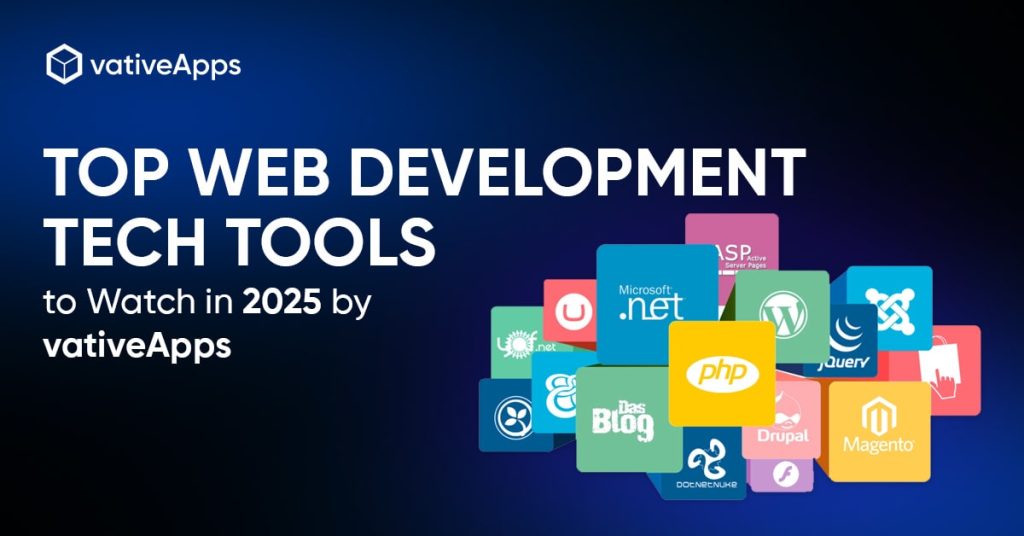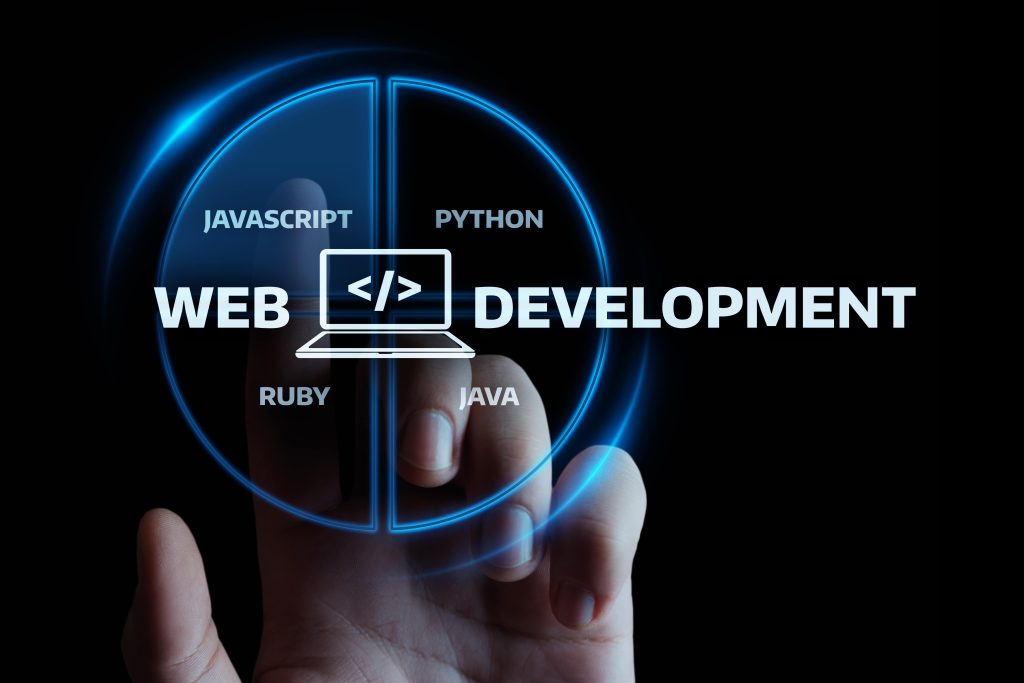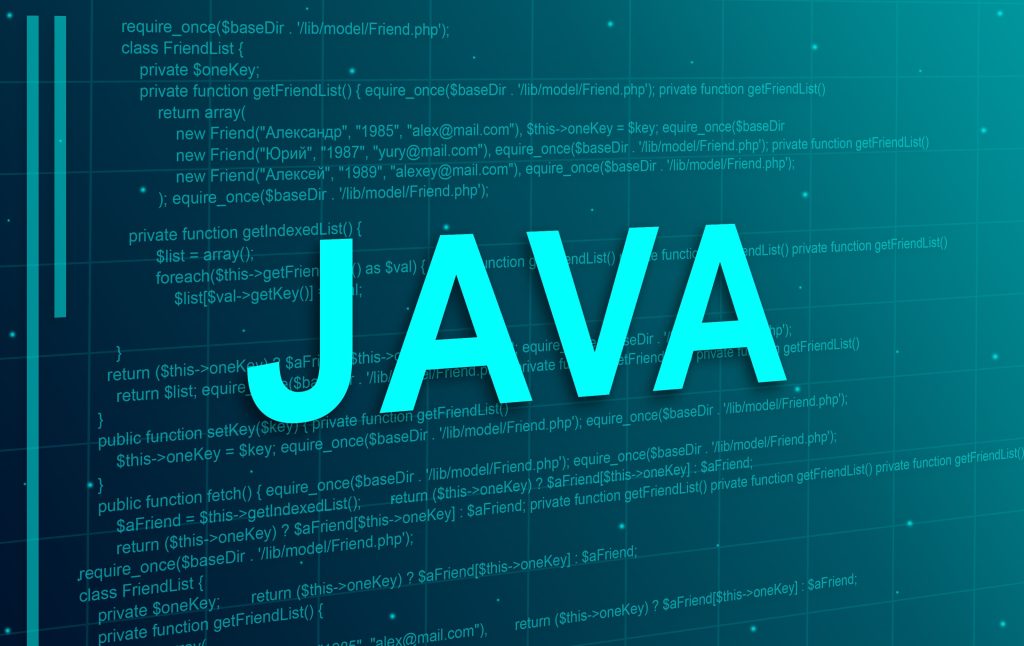
The world is moving fast especially in Digital Transformation and Web Technology, as we are moving in 2025 the landscape of web development is no longer to just talk about building functional websites, It is all about delivering smarter, faster and more intuitive digital experiences.
At vativeApps, we’re seeing a surge in cutting-edge tools and frameworks that redefine how developers and businesses approach building for the web. But with so many options out there, knowing what’s truly valuable can be overwhelming.
So, we’ve broken it down for you: here’s a curated look at the most impactful front-end and back-end web technologies, along with emerging trends that are shaping the future of web development.
Front-End Web Technologies Take Over in 2025
What you see at a first glance is a home screen of a website which engages users to explore more because it establishes the tone of the entire experience. Leading the charge in that evolution below are the following Top Web Development Technologies:

- React – Front-End Power House
React is at the forefront of the front-end market in 2025. With its unparalleled combination of developer friendliness, scalability, and performance. React was first created to make user interface development easier, but it has since expanded into a thriving ecosystem that is utilized by anything from startups to enterprise-level projects.
When Should You Use React?
React is a smart choice for:
- Applications that require frequent UI updates
- Single-page applications (SPAs)
- Projects that demand high interactivity or scalability
What’s New in 2025:
- React 18+ Concurrent Features: Smoother UI rendering with concurrent mode makes complex interfaces more responsive.
- React Server Components: Better performance for content-heavy apps with reduced client-side load.
- Improved Dev Tools & Compiler Enhancements: Faster builds and more intuitive debugging.
React Domination in 2025:
- Virtual DOM equals Speed: By increasing rendering efficiency, React’s virtual DOM makes it possible to create dynamic, quick interfaces.
- Scalable Architecture: React is designed for contemporary, large-scale applications and is paired with tools like Next.js (for SSR) and Redux (for state management).
- Developer Ecosystem: React development is now quicker and more collaborative than ever thanks to a sizable international community, educational materials, and third-party libraries.
- Vue.js – Small, Flexible, and Fast Growing
Thanks to the simplicity and adaptability of Vue.js that has carved out a strong presence in front-end development. Without sacrificing power for a gentle learning curve it is popular among development professionals.
Vue Technology is chosen by those teams who want to control, speed, and flexibility – whether they are building a small prototype or scaling up a full-featured application.
What’s Driving Vue’s Growth:
- Growing adoption in Asia and emerging tech markets.
- Increased integration with TypeScript.
- Active core team and steady updates focused on developer experience.

When to Choose Vue:
Vue is a great fit if you need:
- Quick MVP development or fast time-to-market
- Simple integration into existing projects
- A lightweight alternative to React for less complex front-ends.
Stand Outs of Vue in 2025
- Modular and Lightweight: Use it as a drop-in library or as a complete framework — Vue adapts to your project size.
- Clear Syntax: Its structure is intuitive, making it easy for developers (especially those new to modern frameworks) to onboard quickly.
- Official Tools: With tools like Vue CLI, Vue Router, and Pinia (Vuex’s modern replacement), Vue offers a seamless development experience.
- Angular – Built for Structured, Large-Scale Applications
A go-to framework for enterprise-level front-end development in 2025, Angular backed by Google.
Angular makes it perfect for intricate, scalable web applications although it has a higher learning curve than some of its competitors, it provides a comprehensive solution right out of the box.
When to Use Angular: When is Angular a wise choice?
- You’re creating a sophisticated, business-level online application.
- Several teams or developers are involved in your project.
- Priorities include structure, maintainability, and long-term scalability.
Angular in 2025:
- Continued support and updates from Google
- Improved performance and bundle optimization features
- Strong community with mature ecosystem for plugins and UI components
Why Angular Matters in 2025 Still:
- All-in-One Framework: Angular includes everything you need — routing, forms, HTTP client, state management, and testing tools — no need for piecing together libraries.
- TypeScript-Powered: Angular is built entirely with TypeScript, which adds static typing and enhances code quality, maintainability, and team collaboration.
- Two-Way Data Binding: Syncs data between the model and view in real time, reducing manual updates and simplifying UI logic.
- Strong CLI Tools: Angular CLI automates many setup and build processes, speeding up development and enforcing best practices.
- Bootstrap – Fast, Responsive UI Made Simple
And for a good reason Bootstrap remains one of the best and most widely used front-end frameworks in 2025. With a clean and professional look it is a tired and true solution for quickly building responsive mobile first websites.
Bootstrap helps speed up development without needing deep CSS expertise. Whether you’re prototyping or launching a production-ready site.
When to Use Bootstrap:
- You want a professional UI with minimal design overhead.
- You’re launching fast and need reusable, responsive components.
- Your team lacks dedicated UI/UX designers.
How Bootstrap Holds Up in 2025:
- Improved customization APIs and support for utility classes.
- Leaner and more modular CSS files for better performance.
- Still one of the best choices for non-design-heavy or B2B applications.

Why Developers Continue to Use Bootstrap:
- Prebuilt Components: From buttons and navbars to modals and alerts — Bootstrap provides ready-to-use UI elements that reduce build time significantly.
- Responsive Grid System: Its flexible 12-column grid makes designing for all screen sizes seamless and intuitive.
- Easy Customization: Bootstrap can be themed and extended to match your brand, and it integrates well with modern tools like SASS and Gulp.
- Good for Rapid MVPs: Ideal for startups or small teams needing a solid UI without reinventing the wheel.
- Backbone.js: A Simple Framework for Detailed Front-Ends
Backbone.js still holds its ground in 2025 for projects that value flexibility and minimalism, while not as mainstream as newer frameworks. It provides just enough structure to organize JavaScript-heavy applications without enforcing strict conventions.
For developers who prefer full control over their architecture or want to layer structure on top of existing code, Backbone remains a reliable choice.
When to Use Backbone:
- You’re working with an older codebase and need to modernize gradually.
- Your project requires flexibility without a heavyweight framework.
- You prefer building a custom stack from the ground up.
Why It Still Alive in 2025:
- Minimal dependencies and lightweight footprint.
- Excellent for adding structure to legacy or hybrid systems.
- Gives experienced developers full architectural control.
What Makes Backbone.js Unique:
- MVC Pattern Support: Backbone brings the classic Model-View-Controller architecture to JavaScript apps, keeping your code organized and maintainable.
- Event-Driven Communication: Models in Backbone trigger events that keep views updated — perfect for dynamic UIs.
- RESTful Integration: Easily syncs with REST APIs, making it a solid option for applications with heavy back-end communication.
Top Back-End Web Development Technologies in 2025
In 2025, back-end technologies are evolving rapidly to support real-time data, AI integration, and cloud-native architectures. Behind every great user experience is always a powerful support known as Back-End, the engine that drives performance, security and scalability. Whether you are building a fast API or a complex enterprise system, choosing the right back-end stack is critical for success.
Let’s explore the most reliable and forward-looking back-end technologies shaping modern web development in 2025.

- Node.js & Deno – JavaScript Power on the Server Side
In 2025, Node.js will remain one of the most popular and trusted platforms for building scalable, high performance server side applications. Alongside Deno, a modern runtime created by Node’s original developer to gain transactions as a secure, forward thinking alternative.
Javascript has long ruled the front-end and with Node.js to the back-end too.
When to Choose Node or Deno:
- Use Node.js if you rely on its mature ecosystem, community support, and existing tools.
- Try Deno for new projects that prioritize security, simplicity, and modern JavaScript standards.
Why Node.js Remains a Back-End Favorite:
- Non-blocking Architecture: Its event-driven model handles multiple requests simultaneously, making it ideal for real-time apps like chats, streaming platforms, and APIs.
- Massive Ecosystem: With frameworks like Express.js and NestJS, developers can move fast while keeping code organized and production-ready.
- Full-Stack Efficiency: Using JavaScript (or TypeScript) across both front and back ends creates a seamless developer experience.
- Python (Django & FastAPI) – Simplicity Meets Performance
Python remains one of the most versatile and developer-friendly languages in 2025, and it continues to thrive in web development thanks to powerful frameworks like Django and FastAPI.
Whether you’re building a full-featured web app or a high-speed API, Python offers the right mix of readability, rapid development, and scalability.
When to Use Django or FastAPI:
- Choose Django for full-stack applications with a structured, batteries-included approach.
- Choose FastAPI for building fast, modern APIs or microservices where performance is key.
Why Python Is Still a Top Choice:
- Clean, Readable Syntax: Python makes it easy to write and maintain code, especially in large teams or fast-moving projects.
- Vast Ecosystem: From web frameworks to machine learning libraries, Python integrates easily with modern tech stacks and advanced use cases.

- Ruby on Rails – Fast Development with Clean Architecture
Ruby on Rails continues to be a revolutionary and reliable choice for developers who prioritize rapid development, clean mode, and convention over configuration in 2025. Rails is known for its elegant syntax and built in tooling, particularly well-suited for startups and growing businesses looking to build scalable products quickly.
Best Use Cases for Rails:
- Ideal for MVPs and early-stage products needing quick iteration
- Great fit for content-driven platforms, eCommerce, and internal tools
- Trusted by major platforms like GitHub, Shopify, and Basecamp
Why Teams Still Choose Rails:
- Easy onboarding for new developers.
- Encourages best practices through its opinionated design.
- Seamless integration with frontend tools and APIs.
Why Rails Still Works in 2025:
- Rapid Development: With features like scaffolding, generators, and built-in ORM (ActiveRecord), Rails helps teams move from idea to launch faster than most frameworks.
- Convention Over Configuration: Rails handles a lot of decisions behind the scenes, allowing developers to focus on building features instead of setting up infrastructure.
- Strong Community & Gems: A rich ecosystem of reusable libraries (“gems”) makes extending Rails apps easy and efficient.
- PHP & Laravel – Modern Web Development with a Classic Language
In 2025, PHP remains a major force in back-end web development especially when paired with powerful Laravel Framework. While PHP has been around for decades, it’s far from outdated.
Laravel brings modern development practices, elegant syntax, and built-in features that transform PHP into a productive, secure, and scalable solution for building web applications.
When to Use PHP & Laravel:
- Ideal for custom web platforms, content-heavy applications, and CRM or admin dashboards.
- A solid choice for teams looking for a modern framework without switching away from PHP.
- Especially beneficial for SMBs and agencies needing reliable, cost-effective solutions.
Why Laravel Is a Game Changer:
- Elegant Syntax: Laravel focuses on developer happiness with clean, expressive code.
- Batteries Included: Features like routing, authentication, caching, and queues are ready out of the box.
- Blade Templating Engine: Makes creating dynamic UIs straightforward and organized.
- Robust Ecosystem: Tools like Laravel Forge, Vapor, and Nova support everything from deployment to admin panels.
PHP Still Has a Place in 2025:
- Ubiquity: It powers a large portion of the web, including platforms like WordPress and Magento.
- Ease of Hosting: PHP remains one of the most affordable and widely supported environments.
- Fast Learning Curve: Easy to pick up, making it accessible for junior developers and teams looking for quick onboarding.
- Java – Enterprise-Grade Power That Scales
Java remains one of the most dependable technologies for back-end development in 2025, particularly in enterprise environments. Its long-standing reputation for security, performance, and portability makes it a go-to choice for large, complex systems.
When to Use Java:
- Mission-critical enterprise systems with high reliability needs.
- Applications with long-term lifecycle and strict architectural requirements.
- Teams that demand strong performance, security, and multithreading.
Why Java Stays Relevant:

- Write Once, Run Anywhere: Java applications can run across platforms without rewriting the code — ideal for distributed systems.
- Scalability: Built to handle high-load environments, Java is perfect for banking systems, ERPs, and telecom platforms.
- Rich Ecosystem: Frameworks like Spring Boot, Hibernate, and Jakarta EE help streamline development, testing, and deployment.
- JavaScript (Server-Side) – One Language Across the Full Stack
Traditionally a front-end language, JavaScript has grown into a powerful back-end solution thanks to the rise of Node.js. In 2025, using JavaScript on both the client and server sides is a common strategy for startups and full-stack teams aiming for agility.
Best Use Cases:
- Real-time applications (chat, gaming, streaming)
- RESTful APIs and microservices
- Startups or small teams looking to simplify their tech stack
Why JavaScript Is a Back-End Favorite:
- Unified Codebase: Front-end and back-end logic can be shared, reducing context-switching and improving collaboration.
- Non-Blocking I/O: JavaScript’s asynchronous nature makes it perfect for handling concurrent requests — great for real-time apps.
- Vast Ecosystem: With tools like Express.js, NestJS, and integrations with databases, message queues, and cloud services, JavaScript is more capable than ever.
10 Best Emerging Web Development Trends of 2025

Now that we’ve covered the top web development technologies shaping 2025, let’s take it a step further. To truly stay ahead, it’s essential to embrace the emerging trends that are reshaping how websites and applications are built and experienced.
At vativeApps, we believe that combining the right tools with the right trends is how you build future-ready digital products. Here are the most impactful web development trends you should be watching — and integrating — this year:
| Trend | What It Means in 2025 |
| 1. AI-Driven Development | Automate coding, testing, and debugging with AI tools like GitHub Copilot and ChatGPT for faster development. |
| 2. Voice Search Optimization | Build for voice-first interfaces and smart assistants to improve accessibility and SEO. |
| 3. WebAssembly (Wasm) | 3. WebAssembly (Wasm)Run high-performance code (like C++, Rust) in the browser — perfect for games, CAD tools, and video editing apps. |
| 4. Edge Computing | Shift processing closer to users for faster load times and real-time responsiveness in distributed systems. |
| 5. Micro-Frontends | Break large front-end codebases into manageable, independently deployable modules for scalability. |
| 6. Progressive Web Apps | PWAs offer app-like features (offline access, push notifications) while running in the browser — no app store needed. |
| 7. Low-Code / No-Code | Empower non-developers and speed up delivery using drag-and-drop platforms to build functional applications. |
| 8. Blockchain & Web3 | Build decentralized applications (dApps) with a focus on data ownership, transparency, and user privacy. |
| 9. Dark Mode Standardization | Design interfaces with dark themes by default to improve usability and battery efficiency, especially on OLED devices. |
| 10. Advanced Cybersecurity | Strengthen your applications with MFA, Zero Trust, secure coding practices, and built-in protection against threats. |
From Trends to Action
2025 is all about building faster, smarter, and more secure digital experiences. From sleek, dynamic front-end tools like React, Svelte, and Vue.js to powerful back-end frameworks like Node.js, FastAPI, and Laravel, developers have more flexibility and firepower than ever before.
But at vativeApps, we know that choosing the right stack isn’t just about chasing trends — it’s about aligning with your business goals, user expectations, and long-term scalability.

The technologies and trends shaping 2025 are paving the way for innovation — whether it’s through AI-driven workflows, edge computing, or progressive web apps. If you’re planning to upgrade your current platform, launch a new product, or future-proof your development approach, this is exactly where your research should begin.